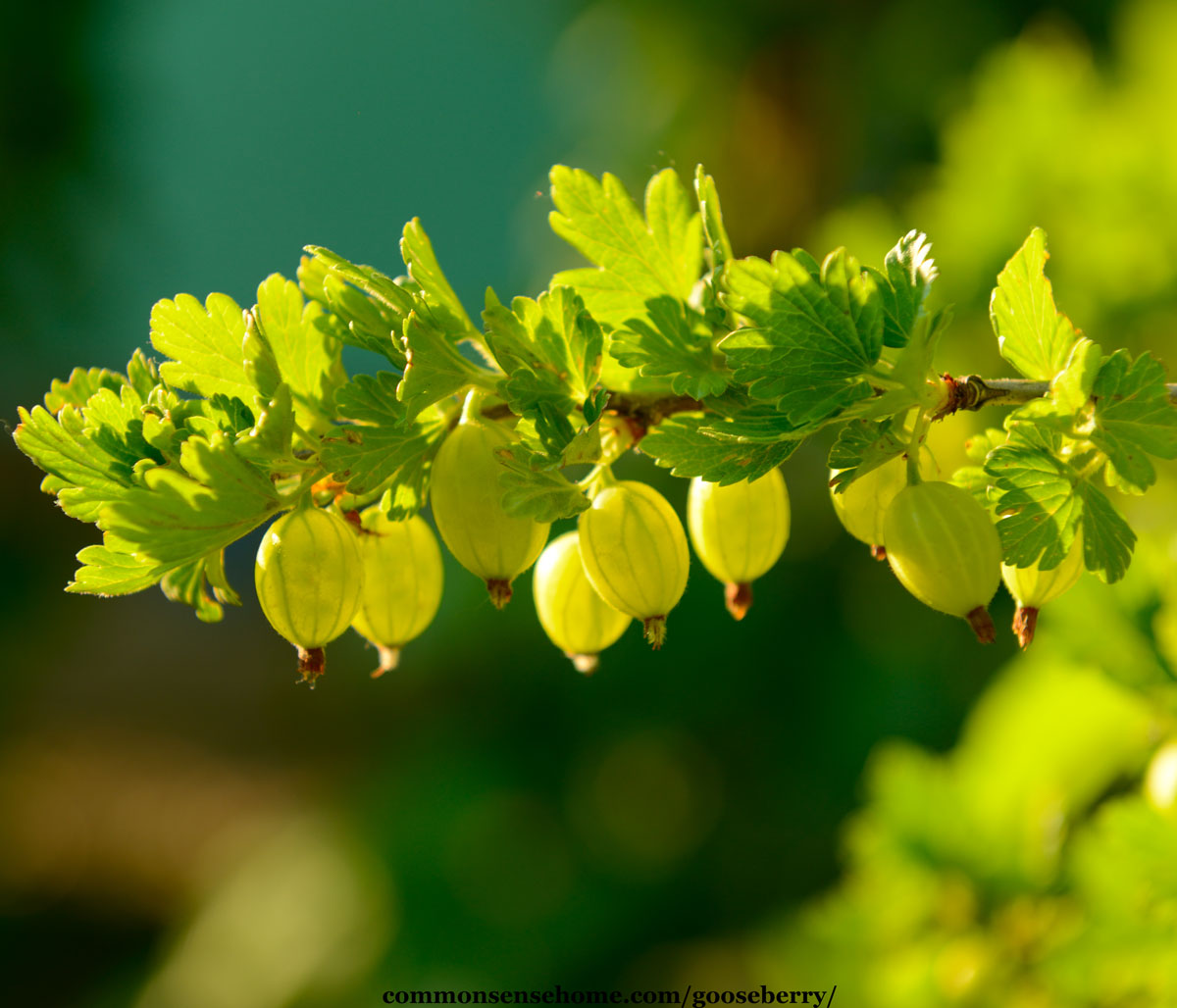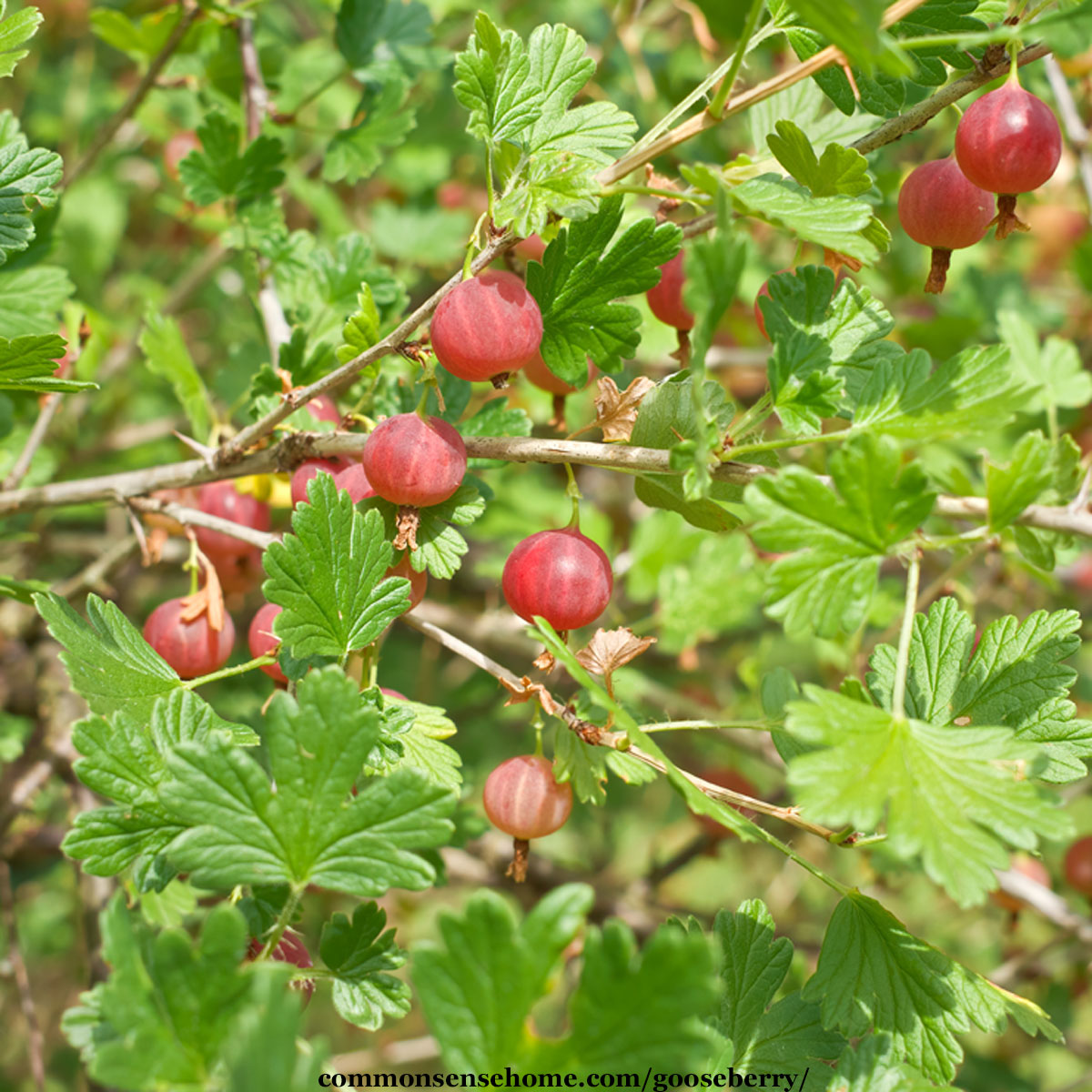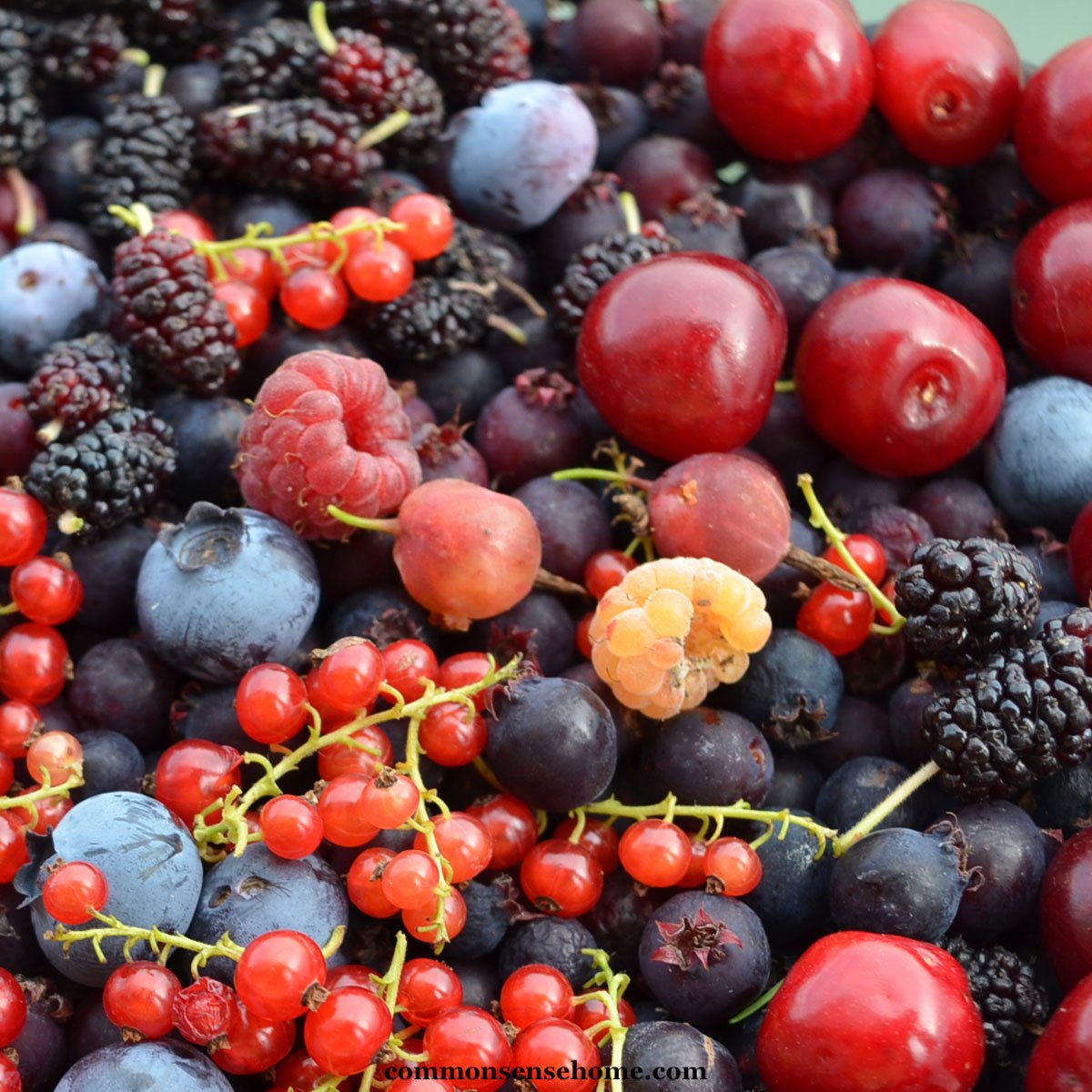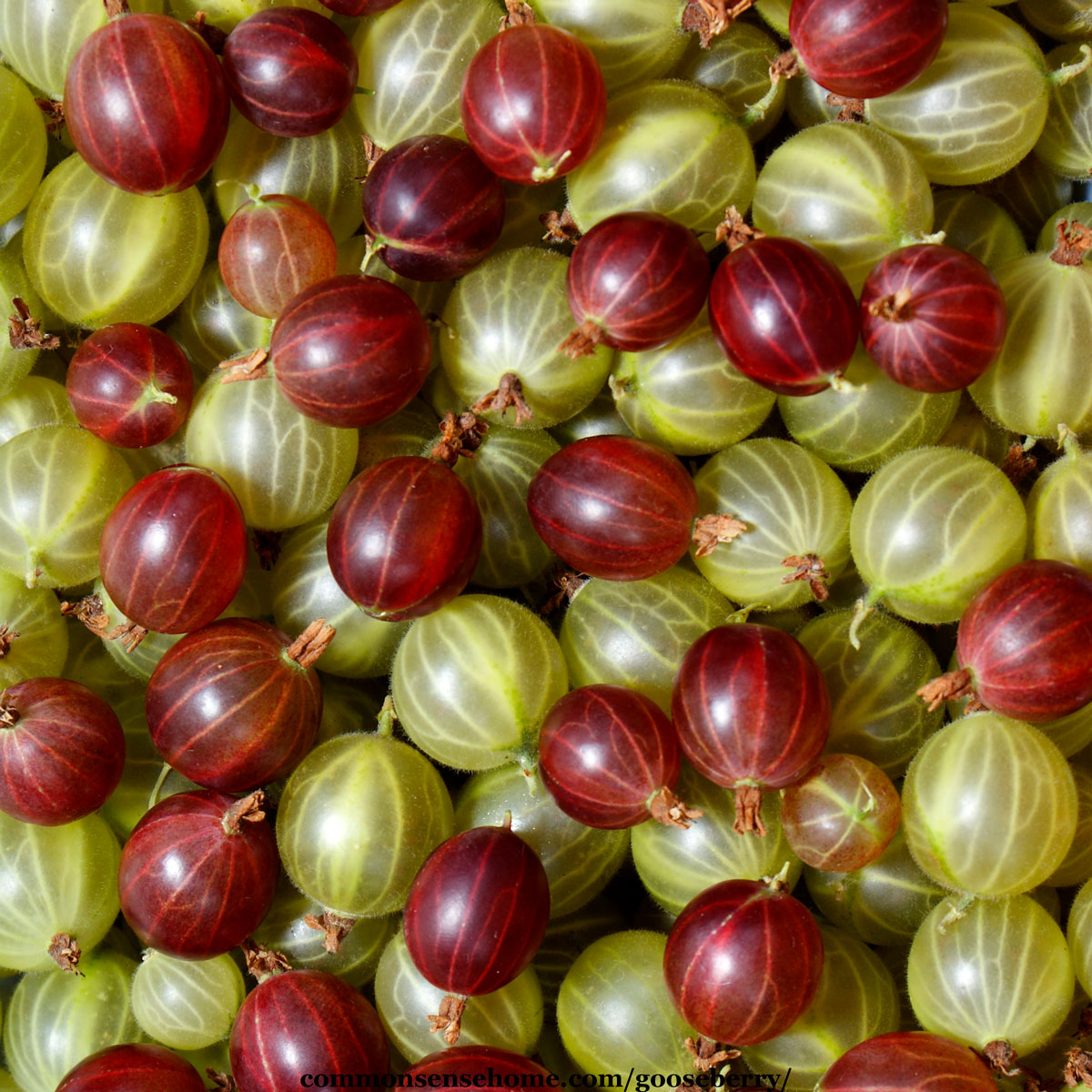Gooseberry Growing Tips, Uses, and Plant Varieties
This post may contain affiliate links. Read my full disclosure here.
Gooseberry plants make an interesting addition to the garden, and are delicious in jams, jellies, and desserts. The ripe berries are tasty raw, and a healthy snack, too. We’ll share growing tips, variety suggestions, and ways to use this unique fruit.

When I was a little girl, my grandmother had a tough little gooseberry bush growing next to an old granary. When the deep red berries were ripe, I’d go out and carefully pick them and pull off the blossom end to suck out the contents of the berry. (Grandma’s berries had a prickly surface.)
Fast forward to our current homestead, where we have an several varieties of gooseberries mixed in the orchard. (None of them have prickers on the berries.) Every time I pick some berries I’m reminded of grandma.
What are gooseberries?
The term “gooseberry” is used for a variety of fruits. In this article, we’re talking about the genus ribes, specifically American and European gooseberries.
American gooseberries (Ribes hirtellum) are native to North America, and found in the northeastern and north-central United States and nearby areas of Canada. European gooseberries (Ribes uva-crispa) hail from the Caucasus Mountains (between Europe and Asia) and North Africa.
American varieties tend to have smaller fruit and be more resistant to powdery mildew and rust. The European types tend to have larger fruit, but the plants aren’t as tough.
These gooseberries are thorny plants that vary in size from 3ft to 5ft tall and 3ft to 6ft wide. They grow in USDA zones 3 thru 8.
The plants bloom with small, pink or white flowers in the spring followed by red, pink, green or yellow edible fruit that ripens in late June or July depending on your season and USDA Zone.
Gooseberries are related to jostaberries (Ribes × nidigrolaria) and currants. Jostaberries are a cross between black currant, North American coastal black gooseberry, and the European gooseberry.
Other plants with the common name “gooseberry” include:
- Cape gooseberry (Physalis peruviana)
- Chinese gooseberry (also known as Kiwi) (Actinidia spp.)
- Indian gooseberry (Phyllanthus emblica)

Growing Gooseberries
Gooseberry plants are self fruitful so you only need a single plant to get fruit. For best productivity:
- Gooseberries produce best in full sun, except in warmer climates, where they benefit from partial shade.
- Choose rich, well-drained soil with pH of around 6-7
- Add 2 to 4 inches of mulch to protect the shallow roots
- The plants prefer a protected area downwind of a windbreak or building
- Gooseberries prefer cool, humid summers and cold winters
- Protect the plants from wildlife
How soon do gooseberries produce fruit?
Plants start producing in 1 to 3 years. When the plants starts to produce, and how long they live, varies with the specific variety and the growing conditions.
How much fruit will they produce?
A single plant can produce 4 to 6 quarts of fruit (around 4 to 5 pounds). Gooseberry plants can produce fruit for up to 50 years with good care and favorable growing conditions.

Planting
Make sure it’s legal to plant gooseberry in your state. Some states ban gooseberries and other ribes plants because they can harbor the white pine blister rust disease. See “State by State Legality of Gooseberry“.
If you can, get your planting location ready in autumn before planting in spring. Smother weeds or grass with mulch to reduce competition for your gooseberry plant. Choose a variety suited to your hardiness zone and your desired use.
Would you like to save this?
When planting, prune the plant back to 4 to 6 aboveground buds. Work some compost into the soil, and nestle the plant in about one inch deeper than it was growing. Bareroot plants benefit from soaking the roots for 3-4 hours before planting so they are well hydrated.
Space plants at least 3 feet apart. It is okay to plant in cold soil, and better to get the plants in early than late.
Care
Gooseberries have shallow roots, so they benefit from mulch and regular watering. The soil should be moist, but not waterlogged. Avoid overwatering when the fruit gets close to ripeness, as it can wash out the flavor of the fruit.
In February or March, prune shoots and leaders that are damaged or older than 3 years Fruit will bear on the 2 or 3 year old shoots. Pruning the plants promotes healthy growth, improves fruit production and maintains plant health. When you are done, a healthy mature gooseberry shrub should have 9 to 12 canes.
Good airflow is critical for avoiding diseases like powdery mildew, which can be a serious problem for gooseberry plants.
After pruning, pull back the mulch and top dress with compost, and then refresh the mulch. This will give the gooseberries plenty of nutrients for fresh growth. Remove weeds as needed to reduce competition.
Wildlife finds the gooseberry plant and berries just as good as humans do. Nearly all rodents, deer, rabbits, squirrels and birds will eat the fruit and/or plant material. Even the thorns don’t slow down the browsers.
Fence or net your plants as needed for protection. See “Blueberry Netting Tips” for ideas.
What do gooseberries taste like, and how do you use them?
The berries have a tart, juicy flesh that is somewhat similar to a grape, but more acidic. They also tend to have a firmer texture, and are loaded with pectin. This makes them a great choice for making jams and jellies.
For fresh eating, allow the fruits to ripen completely for full flavor and sweetness. Remove the stem and blossom “tail” before eating. The fruit is high in fiber and a good source of vitamins C and K.
Gooseberries stay fresh longer than raspberries and strawberries, so you have plenty of time to enjoy them. They’ll easily last for one to two weeks in the refrigerator, or you can freeze them for longer storage.
The less ripe the berry is, the more pectin it has, so mixing ripe and underripe berries is good for jams and jellies. You can make gooseberry jelly in a similar manner to currant jelly.
Their high amount of pectin makes them a good choice for a homemade fruit leather. Gooseberry pie is a favorite old time dessert, and the Saturday Evening Post has a fun assortment of 150 year old recipes from pudding to wine.

Varieties
Popular varieties of gooseberries include: Hinnomaki (red), Hinnomaki (yellow), Invicta (green), and Pixwell (green). There are “less thorny” varieties including: Captivator, Pink Thornless and Friend Red Thornless.
Traditional Gooseberry Varieties
- Hinnomaki Red: This is a popular variety that is known for its sweet flavor and bright red color. The small fruit are about the size of a cherry. The plants are resistant to pests and diseases.
- Hinnomaki Yellow: Similar to Hinnomaki Red, but is yellow instead of red. It has a sweet flavor and is more resistant to pests and diseases.
- Pixwell Green: This green gooseberry has a sweet and juicy texture. The fruit is larger than many other varieties, and the plants are easy to grow and care for.
- Invicta Green: A “white” (pale green) gooseberry with a mild, sweet flavor and a thin skin. The fruit is large and the plants are vigorous and productive.
- Leveller Green: This is a green gooseberry that is known for its sweet, tart flavor, firm flesh and larger fruit but fewer fruit. The plants are easy to grow and care for. Ripens mid June. Good fresh eating desert quality fruit. HIGHLY RATED
- Whinham’s Industry Red: This medium red gooseberry has a sweet, tart flavor and a juicy flesh. The fruit is small to medium in size and the plants are resistant to pests and diseases. Ripens mid June to early July, with the berries hanging on the bush. HIGHLY RATED
- Careless Yellow: This is a yellow gooseberry that has a sweet, juicy flesh and a thin skin. The fruit is small to medium in size and the plants are easy to grow and care for.
“Thornless” Gooseberry Varieties
- Captivator Red: This is a newer Canadian bred variety. The large fruit starts pale green and turns deep red or pink as it matures. Has good disease resistance and nearly thornless with good disease resistance. HIGHLY RATED
- Pink Thornless: Smooth skinned, less thorny, heavy production per plant.
- Friend Red Thornless: Nearly Thornless Ukrainian variety
- Black Velvet Red-Black: This prolific European hybrid has fewer thorns and is quite sweet.
- Hedgehog Ruby Red: Older European variety, less thorny, rich deep ruby red berry, with good dessert quality flavor.
- Pax Red: UK/European hybrid is nearly thornless, large red sweet berry, ripens mid season. Good mildew and leaf spot resistance.
European / UK Varieties
- Early Sulphur Yellow: Ripening as early as late May or Early June depending on the season and USDA zone. Good flavor, older variety.
- May Kuke Red: Can be used while still green but great fresh eating when red and ripe. Early ripening in late May and early June, the skin smooth which is good for fresh eating.
- Martlet Red: Very high yielding newer variety. Ripens early to late June.
- Broom Girl Yellow: large older variety that ripens mid to late June.
- White Eagle White-Green: Thin skinned and transparent when ripe. Ripens mid to late June.
- Rokula Dark Red: New, very popular heavy yielding with excellent production and flavor. Ripens Mid June
- Golden Drop Yellow: Thin skinned, fine dessert quality ripens later June into July.
- Achilles Ruby Red: Older variety, high sugar content, small to moderate sized. Ripens late June early July.
- Lord Derby Red: Large deep red flavorful dessert quality fruit. Lighter crops but good fruit and mildew resistance.
- Lancashire Lad Red: Older variety ripens later in July depending on conditions and location.




we have the prickley kind here in southern michigan. they are growing wild. i have not been able to get enough to make anything yet…….and the birds / animals seem to get them first!
Those are probably natives, which is good because you know gooseberries will grow in your area, and they are tough. The downside is that as you’ve found, it’s tough to get enough to make anything. The modern cultivars tend to have bigger berries, and more of them, and usually don’t have prickers on the berries. I suspect grandma’s plant was a native, too.